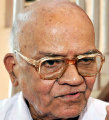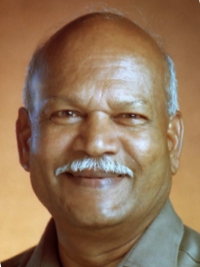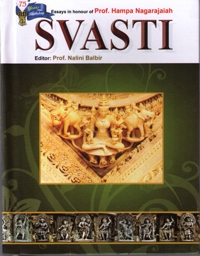4
An Interesting Jaina Inscription from Varānga (Karnataka)
Varānga is a small village situated in the Karkala taluk of South Kanara District of Karnataka State. It was a flourishing Jaina religious centre in the medieval days. It was considered as one of the most sacred seats of the Jainas along with Dilli, Malayādri, Vijayanagara and Poṭṭa Ponbuchcha (Śrī-nija-ghaṭikāsthāna-Dillī-Maḷayādri-Vijayanagara-Varānga-Poṭṭa-Pombuchcha-chaturvidha-siddha-siṃhāsana).[1] Dr. Desai found this list in a Paṭṭāvali or the genealogical list of the pontificate of the Jaina basadi at Maḷkhēḍ in Karnataka. Incidentally, Dr. Desai also equated Malayadri with Maḷkhēḍ. Interestingly his conjecture is vindicated by an inscription at Varānga itself which contains an almost similar statement in relation to a Jaina saint at Varānga (Ḍhilli-Maḷeyakhēḍa-Vijayanagara-sajjana dharma-siṃhāsanādhīśvara).[2] It may be noted that the latter statement replaces Malayādri with Maḷeyakhēḍa which is the same as Maḷkhēḍ. In a legendary fashion another inscription from Varānga seems to indicate that the place name Varānga came from a dignitary of that name (Varānganeṃba mahāpuruṣaṃ dharmavam māḍi).[3]
In fact it was not Varānga alone but the whole of Karnataka that was a congenial ground for the growth and thriving of Jainism throughout the historical period. Right from the days of the early Kadambas of the 4th-6th cent. A.D., down the end of the rule of Vijayanagara up to 17th cent, Jainism received benevolent patronage not only from the ruling class but also from the trading community and the general public. This is vouchsafed by the vast amount of Jaina literature produced in this period, numerous Jaina monuments in the form of basadis and sculptures that dot the whole of Karnataka landscape and the very large number of Jaina inscriptions that are spread over the entire land of Karnataka. Rightly therefore has an inscription averred that Karnataka was the abode of Jainism (Idu Jaināvāsam-ādattu..... chāru-Karnāṭa-dēśaṃ).
The inscription under discussion is found engraved on a slab set up in the outer Varandah of the famous Nēminātha basadi at Varānga.[4] It pertains to the rule of the Vijayanagara king Kṣṇadēvarāya and is dated Śaka 1437, Bhāva, Māgha śu 5, Friday, corresponding to 1515 A.D., January 19, Friday. The main purpose of the record is to register the renewal of a grant which had lapsed over years. As the record puts it, Dēvēndrakīrtti-bhaṭṭāraka, the presiding priest of the Nēminātha basadi brought to the notice of the king Kṣṇadēvarāya who possibly visited the basadi in Varānga in the course of a pilgrimage (dharma-prasanga) that, earlier, the then king Dēvarāya II (1422-46 A.D.) had made a grant of certain lands for the worship and offerings to the Jina Nēminātha of Varānga and for the feeding of the ascetics there. But due to the ignorance or indifference (ajñāna dōṣadiṃda) of the seniors or the elders i.e., the predecessors of Devendrakirti, the grant-lands had elapsed (vtti-kṣētragaḷu naṣṭavāda saṃbandha) since they were infested with wild growth (kāḍanu beḷesidda kāraṇa). Obviously the ascetic appealed to the king to revive the grant. Thereupon the king ordered Ratnappa-oḍeya, the governor of Tuḷu-rājya to look into the matter. The latter got the wild growth cleared and entrusted as much land as was specified in the previous grant (pūrva-śāsana-pramāṇinalli). It was also stipulated that
- The government has nothing to do with the trees like jackfruit, mango, coconut and betel-nut grown in the grant-land and that the donees alone should enjoy them.
- There would be no monetary transactions (arthārtha-vtti) between the government and donees, pertaining to the grant-land, i.e., the donees were not obliged to pay any rent or tax to the government.
More interesting part of the story is that a record of the grant said to have been made earlier by Dēvarāya has been found in the form of an inscription in the Nēminātha basadiitself at Varānga. It is set up in the inner shrine of the basadi.[5] The record is dated Śaka 1346, Krōdhi, Puṣya su 6, Wednesday, corresponding to 1424 A.D., December 27, Wednesday. This situation positively reflects on the system of keeping official records, which were obviously maintained systematically. There is a gap of 91 years between the two records. Dēvēndrakīrti of the inscription of 1515 A.D., must have come to know about the grant through some document such as a copper-plate grant or a palm leaf record preserved in the pontificate of the Nēminātha basadi. Of course the inscription of 1424 A.D., was very much there in the public gaze, in the basadi itself.
The inscription of 1515 A.D., states that the ascetics of the Nēminātha basadi belonged to the Mūla-sangha, Balātkāra-gaṇa and Sarasvatī-gachcha which came down from the sage Kundakundāchārya. The spiritual genealogy of the ascetics is given as below:
The first named Vidyānanda belonged to the lineage of Kundakundāchārya. His successor on the religious seat (tadīya-paṭṭa) was Vādīndra. His successor was Vidyānanda. The latter’s successor was Bhaṭṭāraka and his disciple (śiṣya) was Vardhamāna. This Vardhamāna is the same as Vardhamāna, mentioned in the inscription of 1424 A.D., who was the recipient of the grant by the king Dēvarāya. This is clear from the fact that in the latter record also, Vardhamāna is described as the disciple (tat-śiṣya) of Bhaṭṭāraka. This Bhaṭṭāraka also belonged to the same sangha, gaṇa and gachcha mentioned above. Dēvēndrakīrti-bhaṭṭāraka who was instrumental in the renewal of the grant is mentioned immediately after Vardhamāna, the recipient of the earlier grant. But he cannot be assumed to be the immediate successor of Vardhamāna, since there is a gap of 91 years between the two. At least three generations must have passed between the two. This is also indicated by the statement of the inscription of 1515 A.D., which states that the seniors (hiriya) or the predecessors of Dēvēndrakīrti were responsible for the negligence and the consequent disuse of the grant. This happening also anticipates lapse of considerable time in between.
Yet another inscription also from Varānga which is set up in the same basadi, and is dated in 1522 A.D.,[6] mentions the names of Bhaṭṭāraka and Vardhamāna as preceptor and disciple respectively. These names are followed by Dēvēndrakīrti-bhaṭṭāraka, but without specific mention of relationship between the two. This also suggests that there was a gap of time between Vardhamāna and Devendrakīrti.
Devendrakīrti appears to have occupied an honoured position in his period. The inscription of 1522 A.D., mentioned above, describes him as occupying the noble dharma-siṃhāsana of Ḍhiḷḷi (i.e., Delhi), Maḷeyakhēḍa (i.e., Maḷkhēḍ in Gulburga district) and Vijayanagara. His disciple Immadi Bhairvarasa, the chief of Kaḷasa-Kārkaḷa decorated the Nēminātha basadi with copper sheets and granted a village renaming it Bhairavapura, for the worship and offerings of the deity.
The inscription under study gives yet another interesting information. We have seen above that the inscription gives the spiritual genealogy of the pontificate of the Nēminātha basadi. It states that Vādīndra, the second in the list was given the title Vādi-vaibhava (the glory of disputations) by Mahamanda Suritāṇa i.e., Mahamad Sultān (Mahamanda-suritāṇa dattayā Vādi-vaibhavaḥ). The text is not grammatically correct but it indicates that Vādīndra was given the title Vādi-vaibhava by Mahamanda-Suritrāṇa. The question is as to who this Mahamanda-Suritrāṇa i.e., Muhammad Sultān, was, who honoured the Jaina saint. Vardhamāna was the contemporary of Dēvarāya II while Vādīndra lived 3 generations earlier. Alloting the usual 25 years for each generation, Vādīndra can be placed in around 1350 A.D., i.e., during the period of Bukka I. Which Muhammad Sultan could be the contemporary of Bukka I? Indeed, Muslims had already come to stay on the northern borders of the Vijayanagara empire and the Bahmani kingdom was just then rising. The second ruler viz., Mahammad Shah of this dynasty could be the contemporary of Bukka I. But it is difficult to connect him in any way with South Kanara.
The inscription of 1522 A.D. mentioned above also gives the genealogical details of these saints. It also mentions Vādīndra’s predecessor Vidyānanda and seems to associate him with Ahamanda-suratāṇa of Vēṇāpura. But since the concerned portion of the inscription is damaged, it is difficult to know the exact import of the passage. While Ahamanda can be equated with Mahamanda of the inscription of 1515 A.D., it is difficult to ascertain his relationship with the ruling king. Though it may be surmised that he could be an officer at Vēṇāpura i.e., Vēṇūr (presently a village near Karkala) under Immaḍi Bhaiavarasa it is difficult to imagine that the Muslims were holding some position under the Vijayanagara rulers in so early a period.
The imprecatory verses in inscriptions generally state that those who transgress a grant would go to hell or something like that. But interestingly, the inscription under study prescribes the payment of heavy penalty for violating the grant: sādhanakke tappidavaru tathā-tithiyiṃda hiṃde ayivattu varuṣada hīnāyada honnanu rāya-bhaṇḍārakke teṛuveü i.e., he would pay to the royal treasury, as penalty, an amount equal to the income of 50 years backwards, from the said date i.e., 19th January 1515 A.D., which is the date of the record. The points of interest are the terms tathā-tithi and hīnāyada honnu. Tathā-tithi figures elsewhere also and its exact English equivalent is ‘the said date.’ The term hīnāyada honnu appears here for the first time and we are inclined to interpret it as money for humiliation i.e., penalty for having committed a crime.
The verses leveling curses on the wrong doers are also interesting and unusual in this inscription. One such verse says that the transgressor is like the one who mixes deadly poison (singi) in the plate of food (harivāṇa) of the king, he is like the one who destroys with his own hand, his whole family, and he is like the one who breaks the idol of his own favourite deity.
 Prof. Dr. Shrinivas Ritti
Prof. Dr. Shrinivas Ritti

